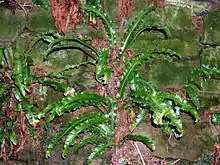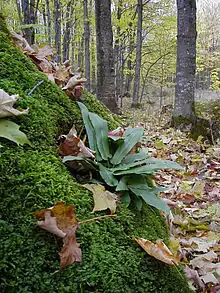Asplenium scolopendrium
Asplenium scolopendrium, known as hart's-tongue[1] or hart's-tongue fern (syn. Phyllitis scolopendrium) is an evergreen fern in the genus Asplenium, of the Northern Hemisphere.
| Asplenium scolopendrium | |
|---|---|
 | |
| Scientific classification | |
| Kingdom: | Plantae |
| Clade: | Tracheophytes |
| Class: | Polypodiopsida |
| Order: | Polypodiales |
| Suborder: | Aspleniineae |
| Family: | Aspleniaceae |
| Genus: | Asplenium |
| Species: | A. scolopendrium |
| Binomial name | |
| Asplenium scolopendrium | |
| Synonyms | |
| |
Description
The plants are unusual in being ferns with simple, undivided fronds. The tongue-shaped leaves have given rise to the common name "Hart's tongue fern"; a hart being an adult male red deer. The sori pattern is reminiscent of a centipede's legs, and scolopendrium is Latin for "centipede".[2] The leaves are 10–60 cm long and 3–6 cm broad, with sori arranged in rows perpendicular to the rachis.
Taxonomy
A global phylogeny of Asplenium published in 2020 divided the genus into eleven clades,[3] which were given informal names pending further taxonomic study. A. scolopendrium belongs to the "Phyllitis subclade" of the "Phyllitis clade".[4] Members of the Phyllitis clade have undivided or pinnatifid leaf blades with a thick, leathery texture, persistent scales on their stalk, and often possess anastomosing veins. Members of the Phyllitis subclade have undivided leaves with freely branching veins and single or paired sori. They are widely distributed through the Northern Hemisphere.[5] Its closest relative within the subclade is A. komarovii, with which it forms a clade (the former segregate genus Phyllitis) sister to A. sagittatum.[4]
Etymology
The Latin specific epithet scolopendrium is derived from the Greek skolopendra, meaning a centipede or millipede. The underside of the fronds supposedly resembles those insects.[6]
Distribution and habitat
Asplenium scolopendrium is a common diploid species in Europe. In North America it occurs in rare, widely scattered populations that have been given varietal status, A. scolopendrium var. americanum. Morphological differences are minor, but the North American populations are tetraploid.[7]
The plants grow on neutral and lime-rich substrates, including moist soil and damp crevices in old walls, most commonly in shaded situations but occasionally in full sun; plants in full sun are usually stunted and yellowish in colour, while those in full shade are dark green and luxuriant. The rare occurrences of the North American form in the southeastern US are found exclusively in sinkhole pits.[8] These populations may be relics of cooler Pleistocene climates.[9]
In the United States, A. scolopendrium var. americanum was declared endangered in 1989.[8] The reason that the European variety is relatively widespread, and the American variety a rarity, has apparently not been established. A third variety, A. scolopendrium var. lindenii, occurs in southern Mexico and Hispaniola.[7]
A. scolopendrium var. americanum grows in a small number of caves in the United States, two of them being in Alabama. One is Fern Cave, a public cave in Jackson County, Alabama, where it has declined heavily due to illegal plant collecting. The other is located at an undisclosed pit in Morgan County that is off limits due to the land around it being both protected by private landowners and the National Speleological Society.
Uses
Cultivation
Asplenium scolopendrium is often grown as an ornamental plant, with several cultivars selected with varying frond form, including with frilled frond margins, forked fronds and cristate forms. The species has gained the Royal Horticultural Society's Award of Garden Merit,[10] as has the cultivar 'Angustatum'.[11]
The American variety is reputed to be difficult to cultivate, and even in North America most, if not all, cultivated plants are derived from the European forms.[12]
Herbal medicine
This fern was used in the 1800s as a medicinal plant in folk medicine as a spleen tonic and for other uses.[13]
Gallery
 Habitat
Habitat
A cultivar with frilled frond margins. 
A specimen growing in lime mortar on a wall. 
Example of the North American variety.
References
- "BSBI List 2007". Botanical Society of Britain and Ireland. Archived from the original (xls) on 2015-01-25. Retrieved 2014-10-17.
- "Flora Europaea: Asplenium scolopendrium".
- Xu et al. 2020, p. 27.
- Xu et al. 2020, p. 30.
- Xu et al. 2020, p. 41.
- Harrison, Lorraine (2012). RHS Latin for Gardeners. United Kingdom: Mitchell Beazley. ISBN 978-1845337315.
- "Flora of North America: Asplenium scolopendrium var. americanum".
- Currie, Robert R. (September 1993). American hart's-tongue recovery plan (PDF) (Report). Atlanta, Georgia: U.S. Fish and Wildlife Service. Retrieved 2010-02-28.
- Short, John W.; Spaulding, Daniel D. (2012). Ferns of Alabama. Tuscaloosa, AL: University of Alabama Press. ISBN 9780817356477.
- "RHS Plant Selector - Asplenium scolopendrium". Retrieved 12 February 2020.
- "Asplenium scolopendrium 'Angustatum'". RHS. Retrieved 20 February 2020.
- Mickel, John T. (2003). Ferns for American Gardens. Timber Press. ISBN 9780881925982. This book is a reprinting of Mickel, John T. (1994). Ferns for American Gardens. MacMillan.
- Hill, John (1812). The family herbal: or An account of all those English plants, which are remarkable for their virtues, and of the drugs which are produced by vegetables of other countries; with their descriptions and their uses, as proved by experience. C. Brightly and T. Kinnersley. p. 162.
- Xu, Ke-Wang; Zhang, Liang; Rothfels, Carl J.; Smith, Alan R.; Viane, Ronald; Lorence, David; Wood, Kenneth R.; Cheng, Cheng-Wei; Knapp, Ralf; Zhou, Lin; Lu, Ngan Thi; Zhou, Xin-Mao; Wei, Hong-Jin; Fan, Qiang; Chen, Su-Fang; Cicuzza, Daniele; Gao, Xin-Fen; Li, Wen-Bo; Zhang, Li-Bing (2020). "A global plastid phylogeny of the fern genus Asplenium (Aspleniaceae)". Cladistics. 36 (1): 22–71. doi:10.1111/cla.12384.
Further reading
- Hyde, H. A., Wade, A. E., & Harrison, S. G. (1978). Welsh Ferns. National Museum of Wales. ISBN 0-7200-0210-9.
- Parker, Rosemarie (December 2009). "A Real Rarity". Finger Lakes Native Plant Society. A popular article on hart's tongue fern that includes several references and a discussion of cultivation possibilities for the European and American varieties. The article strongly discourages collection and or cultivation of the North American variety.
External links
| Wikimedia Commons has media related to Asplenium scolopendrium. |
